© 2023 Dr. M. Sheppard
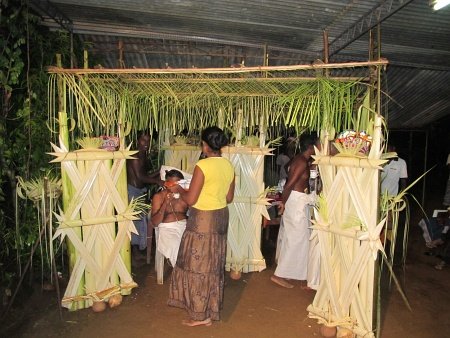
The Demon Palace (Kuduva)
This is the major structure and has variations of construction according to which ceremony is being performed to cure the patient. It is made of mainly banana stems and coconut leaves and should be 7 arms’ lengths square. It has a coconut leaf roof. The inside is divided into sections and has an offering stand fixed to a rice pounder which has driven into the ground. This can be rotated. It is on this that the offerings to the demons will be laid. The Tovil dancers enter from the Demon Palace and retire into it at the end of their dances.
If the patient has been diagnosed as being afflicted by the demon Mahashona, this structure will have at each of the 4 corners large panels (torana) made from flattened out banana tree trunks decorated with a lattice pattern. This criss cross pattern has magical properties that block and restrain demons. The 4 corners are the points where Mahasona or specific forms of him enter and are like rooms. At the top is the offering table for Mangara Deviyo (Mahasona's superior) and at the centre is a painting of Mahasona coloured deep blue black with a wolf’s or bear's head. He is carrying an elephant which he is opening up on its neck to drink its blood. N.B. in the ceremonies that I attended, this picture was usually located to the side of the Performance Area.
At the base of each of the 4 corner panels are small clay pots with coconut and powak (areca) flowers. These pots are for Bumi Devi or Polova Mahi Kantava (Goddess of the Earth). She is the symbol of purity and in Buddha's previous lives is believed to have protected him from a very evil enemy called Mara. The power of these pots is to contain the demons within the Vidiya (palace). Flowers are also placed here and these are offerings to the Deities (Shiva or Isvara; and the 4 guardian Deities of Sri Lanka -
The palace is decorated with leaves – ideally there should be 7 types of these and they are ones associated with Buddha and Ayurverdic medicine. Young coconut leaves decorate the whole palace and hang from its roof. The ends are often cut in the shape of the weapons of the Deities – trident of Isvara who is the Deity who created exorcism.
Constructions used in Curing Ceremonies
To effect a cure it is very important that offerings should be made in the appropriate way. Various structures need to be made at the home of the patient.
These are made by the Devil Dancers and Assistants with extra help from male members of the family where the ceremony is being held. They are overseen by the Edura as it is most important that these structures are built in the correct way for the ceremony to be successful in curing the patient.
A Performance Area will be cleared in front of the patient’s house. Sand is often strewn here as this is where the Tovil Dancers will be performing bare foot so it is most important to remove all stones and thorns or other obstructions. The Demons and ghosts when called by the Edura, are bound within this area so that they cannot harm the audience. This area is called the sima midula (sima – bound).
Structures
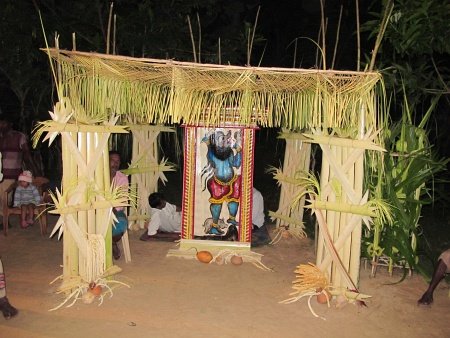
Demon Palace showing painted clay picture of Mahasona (the Cemetery Demon)
Flower Fence
This is for Sataravaram-
This structure is about 4 feet by 4 feet. It is divided into 9 sections divided by sheaves of banana trunks with the inner concave surface face up. Flowers and rice offerings are placed in these for Suniyam. There are 9 divisions for Suniyam and the 9 planets and Suniyam's followers. (N.B. remainder of 5 of offering baskets to demons on chair -
In front of the patients a row of chairs is usually placed on which are offering baskets in which are made offerings to placate the different Deities and demons during the ceremony. Although the affliction is probably only caused by one demon in order for the others not to be jealous and cause more harm, all the main ones are honoured in a ceremony. In addition, offerings are made to the ghosts for the same reason. These offerings are made in offering baskets usually woven from coco-
These are laid out on the chairs with 6 lamps that are kept burning throughout the ceremony. One by one the offering baskets are removed as the individual demons are propitiated.
Offering baskets to the Deities are usually positioned in the following order: Buddha, Vishnu, Kataragama, Saman, Natha and Isvara.
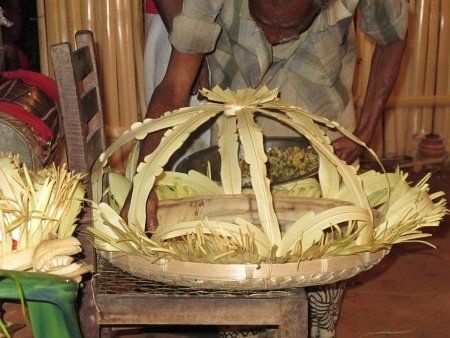
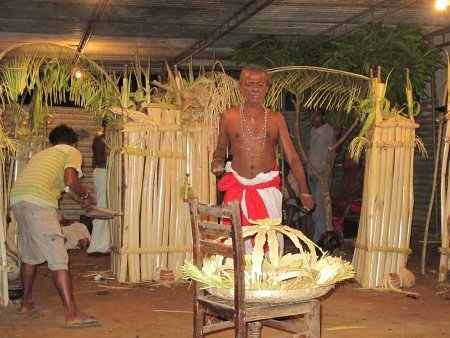
Examples of offering baskets in which offerings are made to placate the disease causing demons
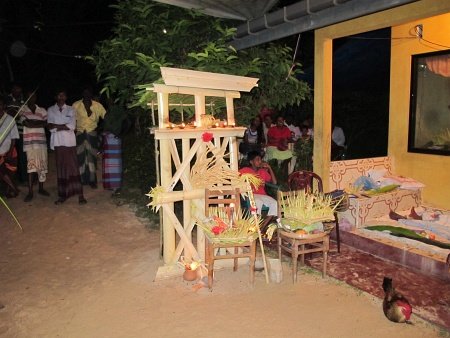
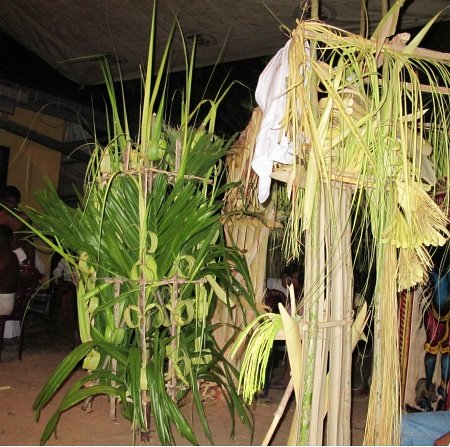
Two different Flower Fences
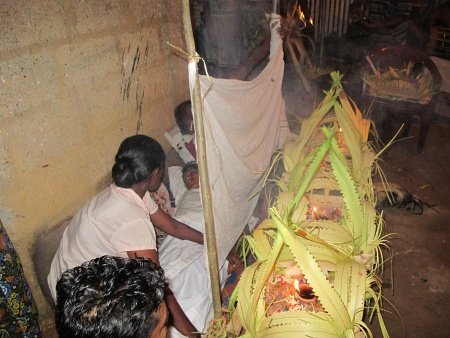
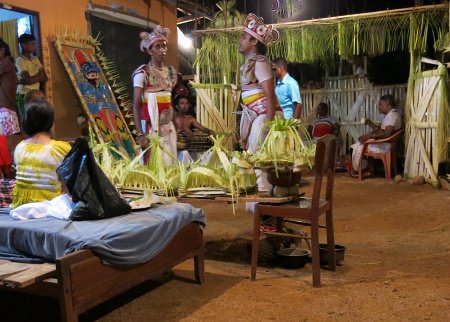
The Kumara Vidaya
This is only constructed when the patient is a woman or girl as it is for the offerings for Kalu-
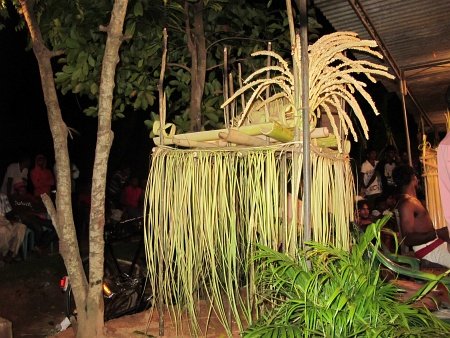
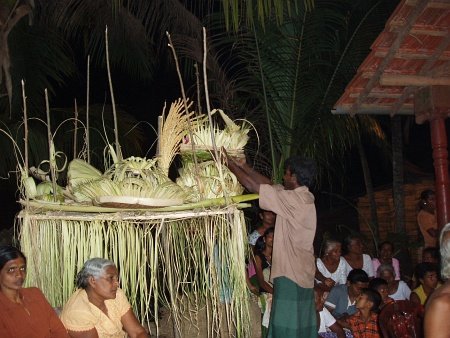
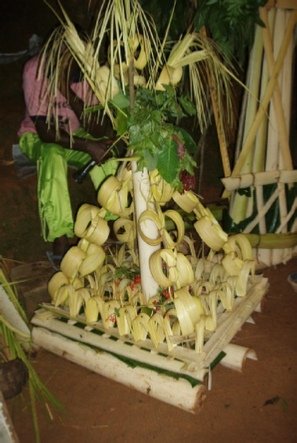
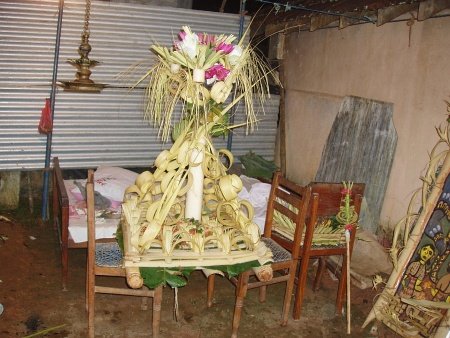
Offerings made in a round clay pot to Kalu-

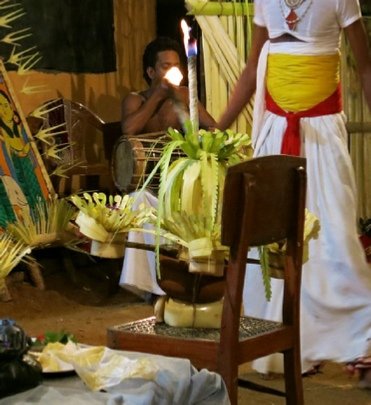

Offering stand used on various occasions e.g. protecting household or site e.g. during Fishermen’s Puja. According to the purpose, different articles are placed inside as offerings
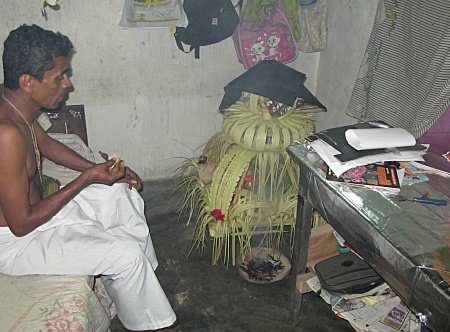
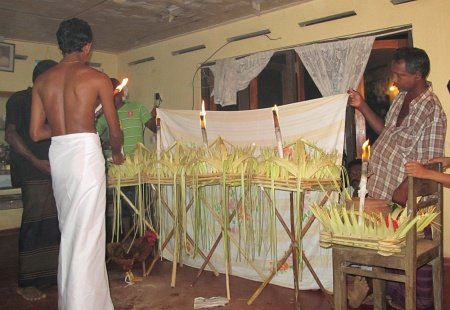
Offering baskets in front of an afflicted family for Family Tovil
Offering Basket being meticulously prepared by the Dancers’ Assistants under the supervision of one of the Tovil Dancers. This offering basket is probably for Hiri-
Offering stand for the ghosts
Offerings must be made to the ghosts of the household so that they do not interfere in the ceremony. There is a specially constructed offering basket (preta Tatluva) on the ground before the porch. It has 4 sticks lashed together like the demon offering stands, but the basket is at the base. The 4 sticks are to contain the ghosts in the basket.
The top is covered by brightly covered cloth. There should be 25 kinds of mixed meat, vegetable curries, 5 kinds of sweet meats, 5 kinds of fruits, kiri & rice, alcohol (toddy, arrack, marijuana and sometimes opium) , stimulants – beddis, cigarettes, cigars and betel nut. Clean water strained through a cloth is poured into a cup which contains 5 metals – gold, silver, lead, copper and iron. The metals could be coins or foil & represent the Earth – one of each of the 5 elements.
By putting offerings on the ground it shows the low status of the ghosts compared to the demons and deities whose offerings are placed on chairs.
The ghosts are called by the head Edura by blowing on his bamboo whistle & smoking the incense over a brazier. At the same time he sings the 7 mantra that tell of a former Buddha at a time when priests did not do offerings properly and were transformed into ghosts. The Edura summons the ghosts and asks them to take the offerings. Buddha and the Deities are named. This takes about 1 hour and then the offering basket is taken into the house into a room not in use.
Then the exorcist goes through the house throwing flaming dummala to purify it and draw the ghosts away from the house otherwise they might steal the later offerings that are to be made to the demons.
Offerings basket for household ghosts. The Edura recites the special mantra and blows on his bamboo pipe to summon them to come and and collect their offerings and not disturb the ceremony.
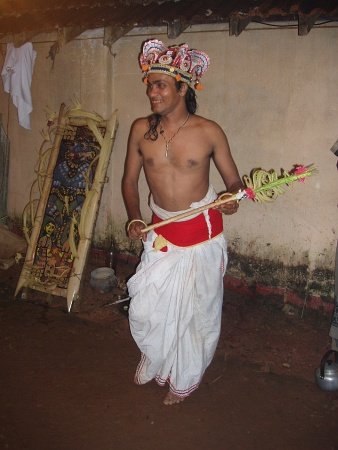
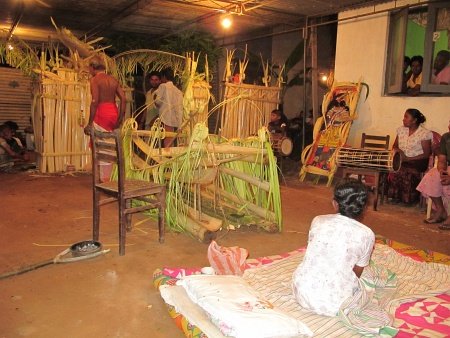
Structure used during Mat Dance (see section on Dances)
Igaba – wand
This is about one metre long and at one end it is decorated by folded strips of palm leaves and areca flowers. A copper coin is tied in a cloth and attached to the wand. This is an offering. This wand is used by the Edura to draw out the affliction from the patient and into the cock.
Bamboo Whistle
This is used to summon the demons to the ceremony, to attract their attention to the offerings being made to them.
The legend (see Paul Wirz page 51-
Mangar1i-
"Om namo! Mangara-
Om Glory to Reverend Buddha!…. come died
navasiyasetevak Mangara-
970 attendants (army) of Mangara -
kada ran-
Taken…gold coloured reed…made whistle… thereupon 970
Mangara-
Followers of Mangara rose…waited..mighty…from today… bamboo whistle voice
asa mana sitin yakun-
Listen near..wait male and female yakku (demons)…sunset (West)…as long as the sun shines
maandagesu tenedi disti-
When I call them..therupon appears appears…quickly quickly ….comes comes”
(Wirz p.52)
Like all mantras the language is very difficult to translate.
Tufts - Samara
These are held in the hands by dancers at various stages of the ceremony. Originally they were made from Samara tails (grunting ox) fixed into wooden handles but nowadays they are bunches of leaves or areca flowers. They are also used to flick medicated water over the patient and/or audience.
For fuller details see Paul Wirz pages 52